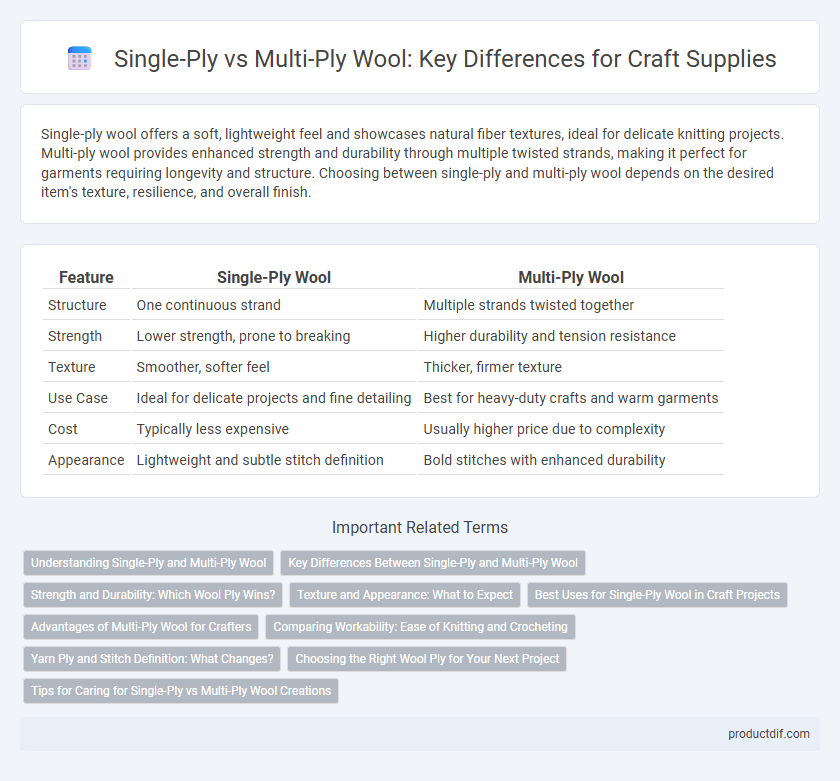Single-ply wool offers a soft, lightweight feel and showcases natural fiber textures, ideal for delicate knitting projects. Multi-ply wool provides enhanced strength and durability through multiple twisted strands, making it perfect for garments requiring longevity and structure. Choosing between single-ply and multi-ply wool depends on the desired item's texture, resilience, and overall finish.
Table of Comparison
| Feature | Single-Ply Wool | Multi-Ply Wool |
|---|---|---|
| Structure | One continuous strand | Multiple strands twisted together |
| Strength | Lower strength, prone to breaking | Higher durability and tension resistance |
| Texture | Smoother, softer feel | Thicker, firmer texture |
| Use Case | Ideal for delicate projects and fine detailing | Best for heavy-duty crafts and warm garments |
| Cost | Typically less expensive | Usually higher price due to complexity |
| Appearance | Lightweight and subtle stitch definition | Bold stitches with enhanced durability |
Understanding Single-Ply and Multi-Ply Wool
Single-ply wool consists of a single strand of fiber, offering a soft and lightweight texture ideal for delicate projects and fine detailing. Multi-ply wool is created by twisting multiple single strands together, enhancing durability, strength, and stitch definition, making it suitable for sweaters and heavy-use garments. Understanding these differences helps crafters select the right wool type based on project requirements and desired texture.
Key Differences Between Single-Ply and Multi-Ply Wool
Single-ply wool consists of a single strand of fiber twisted to form yarn, delivering a softer, lighter texture ideal for delicate knitting projects, while multi-ply wool is made by twisting several single strands together, enhancing strength, durability, and stitch definition. Multi-ply yarns provide better resistance to pilling and are preferred for garments requiring structure and longevity. The choice between single-ply and multi-ply wool directly impacts the finished craft's appearance, feel, and durability.
Strength and Durability: Which Wool Ply Wins?
Multi-ply wool offers superior strength and durability compared to single-ply wool due to the multiple strands twisted together, which enhances resistance to wear and tear. Single-ply wool tends to be softer and lighter but is more prone to pilling and breakage under stress, making it less ideal for projects requiring long-lasting performance. For crafts demanding resilience, such as knitting or crocheting frequently used garments or accessories, multi-ply wool is the preferred choice for longevity.
Texture and Appearance: What to Expect
Single-ply wool features a smooth, sleek texture with a subtle sheen, offering a lightweight and delicate appearance ideal for fine, lace-like projects. In contrast, multi-ply wool combines several strands twisted together, resulting in a thicker, more durable yarn with enhanced stitch definition and a slightly matte finish. Expect single-ply wool to showcase individual fiber characteristics prominently, while multi-ply wool delivers a more even, consistent texture suitable for garments requiring durability and structure.
Best Uses for Single-Ply Wool in Craft Projects
Single-ply wool offers a soft, lightweight texture ideal for delicate craft projects such as baby garments, lace knitting, and fine crochet work. Its smooth, single-strand construction allows for intricate stitch definition, making it perfect for detailed patterns and decorative embroidery. This wool type also works well for layering in mixed-media crafts, where subtle texture and flexibility are essential.
Advantages of Multi-Ply Wool for Crafters
Multi-ply wool offers enhanced durability and strength, making it ideal for projects that require long-lasting wear and resistance to pilling. The multiple strands twisted together provide better stitch definition, which is essential for intricate patterns and detailed design work. Crafters benefit from multi-ply's consistent tension and smooth texture, resulting in more even and professional-looking finished products.
Comparing Workability: Ease of Knitting and Crocheting
Single-ply wool offers a softer, loftier texture that is easier to manipulate for beginners during knitting and crocheting, providing a smooth glide of needles and hooks. Multi-ply wool is more durable and provides better stitch definition, making it ideal for intricate patterns and projects requiring structured shapes. Both types affect workability distinctly, with single-ply favoring ease and fluidity, while multi-ply enhances control and stability in fiber crafts.
Yarn Ply and Stitch Definition: What Changes?
Single-ply wool yarn consists of one strand, offering a softer, loftier texture with a tendency to pill and split, while multi-ply wool is created by twisting multiple strands together, resulting in increased durability and smoothness. Yarn ply directly impacts stitch definition; multi-ply wool provides clearer, crisper stitch patterns due to its structured twist, which helps maintain shape and intricate detailing. Choosing between single-ply and multi-ply wool affects the final fabric's appearance, with multi-ply enhancing stitch clarity and single-ply emphasizing a rustic, cozy aesthetic.
Choosing the Right Wool Ply for Your Next Project
Single-ply wool offers a soft, lightweight texture ideal for delicate projects and fine garments, providing exceptional drape and subtle stitch definition. Multi-ply wool, composed of several twisted strands, delivers enhanced strength, durability, and stitch definition, making it perfect for sturdy items like sweaters, blankets, and accessories that require longevity. Selecting the appropriate wool ply depends on the project's intended use, desired texture, and the balance between softness and durability.
Tips for Caring for Single-Ply vs Multi-Ply Wool Creations
Single-ply wool requires gentle handling to prevent pilling and breakage, with hand washing in cool water and drying flat recommended to maintain its delicate fibers. Multi-ply wool, being sturdier, allows for more frequent use and can often withstand machine washing on a gentle cycle, but still benefits from air drying to preserve elasticity and prevent shrinkage. Proper storage in a cool, dry place with moth repellents extends the lifespan of both single-ply and multi-ply wool creations, keeping crafts in optimal condition.
Single-ply wool vs Multi-ply wool Infographic

 productdif.com
productdif.com